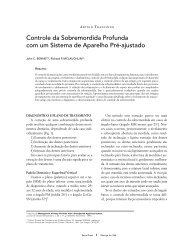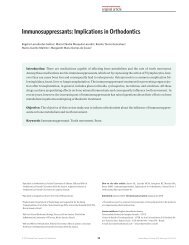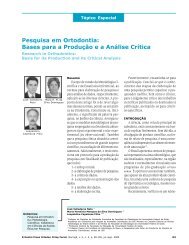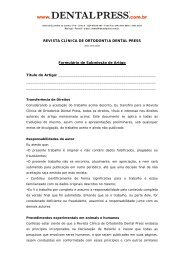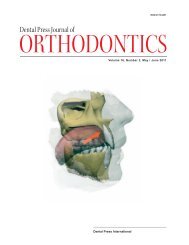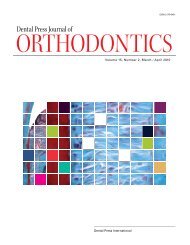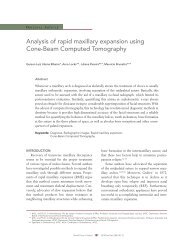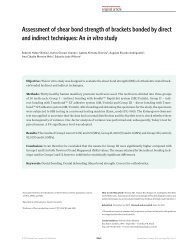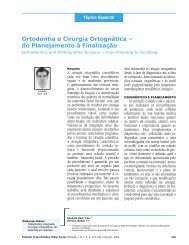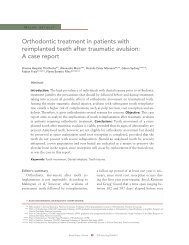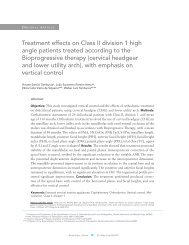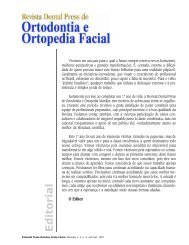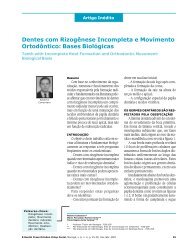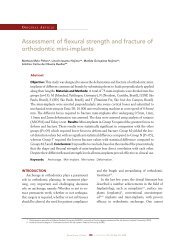Dental Press
Dental Press
Dental Press
You also want an ePaper? Increase the reach of your titles
YUMPU automatically turns print PDFs into web optimized ePapers that Google loves.
Guimarães MRFSG, Gomide HA, Oliveira MAVC, Biffi JCG<br />
condensação lateral, os profissionais exerçam carga constante<br />
e com reduzida pressão em direção apical, obedecendo<br />
sempre o limite de trabalho e de penetração do espaçador.<br />
Na condensação vertical, etapa na qual encontramos<br />
— em três dos endodontistas (B, C e D) — os maiores valores<br />
de força aplicada durante a obturação, recomendamos o<br />
uso do calcador com reduzida força em direção apical. Isso<br />
porque o aumento da força não gerou, radiograficamente,<br />
melhora no resultado final da obturação e pode causar,<br />
especialmente em raízes fragilizadas ou com menor estrutura<br />
dentinária, o aparecimento de defeitos como linhas de<br />
fissura e/ou rachaduras incompletas 1 . Seguindo essas recomendações,<br />
o profissional irá conseguir uma obturação<br />
adequada, gerando pouca tensão às estruturas dentinárias.<br />
O que é um fator importante, pois a fratura vertical radicular<br />
não é um fenômeno que ocorre instantaneamente, mas é<br />
resultado de uma gradual diminuição de estrutura dentária<br />
somada ao emprego de força e pressão à dentina radicular 12 .<br />
Abstract<br />
Objective: Endodontic procedures might contribute to the<br />
development of vertical root fracture as well as other localized<br />
defects such as craze lines or incomplete cracks in root<br />
dentine. The objective of this study was to evaluate the maximum<br />
fracture resistance and the force produced by five different<br />
operators in lateral and vertical condensation during root<br />
canal filling. Methods: 74 human teeth, superior canines (SC)<br />
and inferior premolars (IPM) were selected. In order to determine<br />
the maximum fracture resistance during condensation,<br />
24 teeth were submitted until failure to an axial compression<br />
load in a universal testing machine. Fifty teeth were used in<br />
order to measure the axial condensation force by means of<br />
a device developed to simulate clinical working conditions.<br />
Results: Fracture resistance mean values in kg were:<br />
SC=14.96±2.65 and IPM=7.56±1.05. Mean values of force<br />
applied by each of the five operator in Kg were, respectively:<br />
2.49, 3.75, 2.24, 2.08 and 1.18. None of the operators achieved<br />
teeth’s maximum fracture resistance during procedures. Conclusions:<br />
Different behaviors among five professionals monitored<br />
were observed for the same technique of root canal<br />
filling. The increase in strength during condensation had no<br />
radiographic improvement of root canal filling. During the<br />
root canal filling, lateral and especially vertical condensation,<br />
must be performed with reduced apical strength and pressure,<br />
avoiding excessive and unnecessary stress to root dentin.<br />
Keywords: Lateral condensation technique. Root canal filling.<br />
Condensation force.<br />
Referências<br />
1. Tamse A. Iatrogenic vertical root fractures in endodontically treated<br />
teeth. Endod Dent Traumatol. 1988;4(5):190-6.<br />
2. Hammad M, Qualtrough A, Silikas N. Effect of new obturating<br />
materials on vertical root fracture resistance of endodontically<br />
treated teeth. J Endod. 2007;33(6):732-6.<br />
3. Shemesh H, Bier CAS, Wu M-K, Tanomaru-Filho M, Wesselink<br />
PR. The effects of canal preparation and filling on the incidence of<br />
dentinal defects. Int Endod J. 2009;42(3):208-13.<br />
4. Wilcox LR, Roskelley C, Sutton T. The relationship of root<br />
canal enlargement to finger-spreader induced vertical root<br />
fracture. J Endod 1997;23(8):533-4.<br />
5. Tang W, Wu Y, Smales RJ. Identifying and reducing risks for<br />
potential fractures in endodontically treated teeth. J Endod.<br />
2010;36(4):609-17.<br />
6. Blum JY, Esber S, Micallef JP. Analysis of forces developed<br />
during obturations. Comparison of three gutta-percha<br />
techniques. J Endod. 1997;23(5):340-5.<br />
7. Blum JY, Machtou P, Micallef JP. Analysis of forces developed<br />
during obturations. Wedging effect: Part II. J Endod.<br />
1998;24(4):223-8.<br />
8. Harvey TE, White JT, Leeb IJ. Lateral condensation stress in root<br />
canals. J Endod. 1981;7(4):151-5.<br />
9. Holcomb JQ, Pitts DL, Nicholls JI. Further investigation of spreader<br />
loads required to cause vertical root fracture during lateral<br />
condensation. J Endod. 1987;13(6):277-84.<br />
10. Lertchirakarn V, Palamara JE, Messe HH. Load and strain<br />
during lateral condensation and vertical root fracture. J Endod.<br />
1999;25(2):99-104.<br />
11. Piskin B, Aydın B, Sarikanat M. The effect of spreader size<br />
on fracture resistance of maxillary incisor roots. Int Endod J.<br />
2008;41(1):54-9.<br />
12. Soros C, Zinelis S, Lambrianidis T, Palaghias G. Spreader load<br />
required for vertical root fracture during lateral compaction<br />
ex vivo: evaluation of periodontal simulation and fracture load<br />
information. Oral Surg Oral Med Oral Pathol Oral Radiol Endod.<br />
2008;106(2):e64-e70.<br />
13. Goerig AC, Michelich RJ, Schultz HH. Instrumentation of root<br />
canals in molar using the step-down technique. J Endod.<br />
1982;8(12):550-4.<br />
© 2011 <strong>Dental</strong> <strong>Press</strong> Endodontics 57 <strong>Dental</strong> <strong>Press</strong> Endod. 2011 apr-june;1(1):52-7



